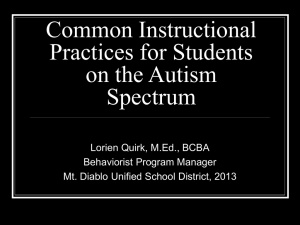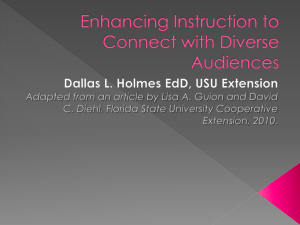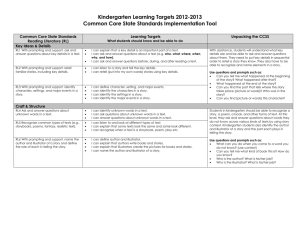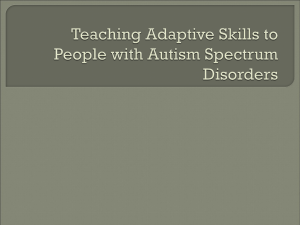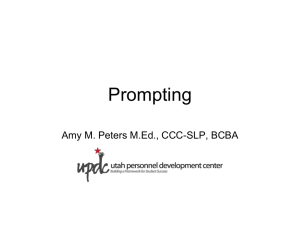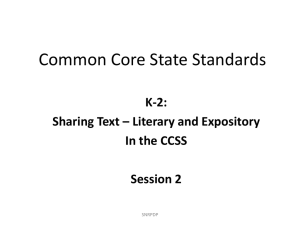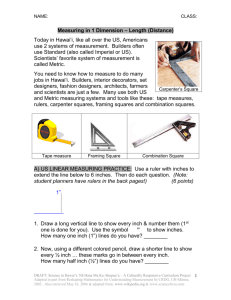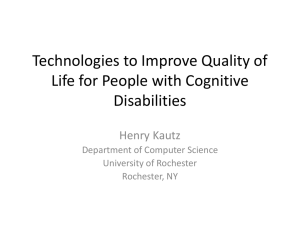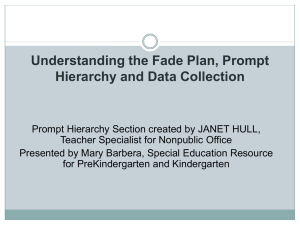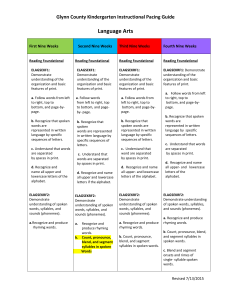Reading for Students with Significant Cognitive Disabilities
advertisement
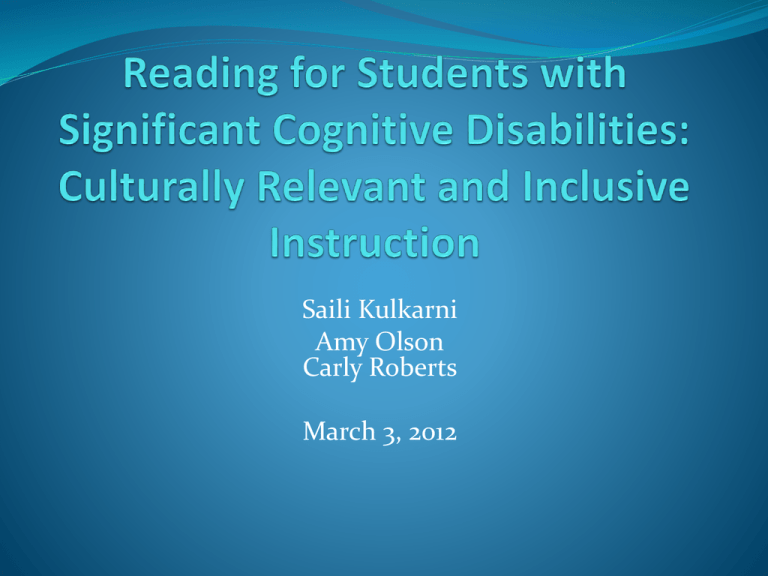
Saili Kulkarni Amy Olson Carly Roberts March 3, 2012 Today’s Agenda Discussion of Culturally Relevant Instruction Discussion of inclusive literacy practices Explore Materials Group Activity Questions? Culturally Relevant Pedagogy (CRP) Success for ALL students Cultural Competence Socio-political consciousness General Strategies that promote CRP Strategies that are considered inclusive best practice are also culturally relevant Reciprocal Teaching (Palinscar & Brown, 1984) Teaching specific concrete strategies that students can reapply to future learning (summarization, question/answer, etc) Cooperative learning groups (Slavin, 1980) Promotes positive race relations in desegregated schools, improves self esteem, group vs. individual responsibility Culturally Relevant Literacy Practices Moves beyond the 3F’s: Food, Fun, Festivals Teachers who are sincerely committed to multicultural education cannot be satisfied with superficial celebrations of heroes and holidays. This approach to content trivializes multicultural education and conveys the idea that diversity issues come into play only during celebratory moments with foods, fun, and festivals. In the multicultural festival model, teachers, students, and parents typically spend lots of time and energy preparing for an all-school activity. Students may do background research about a culture, prepare maps, and help create indigenous costumes. Parents may help to prepare various ethnic foods. On the day of the festival, members of the school community go from class to class, visiting the various cultures, sampling the foods, and enjoying dances, songs, and arts and crafts. At the end of the day, everyone agrees that the annual event has been a great success. Then teachers and students go back to their “real work”. In the transformative model, on the other hand, multicultural education is not a separate, isolated, once-a-year activity. Instead, the regular curriculum includes a range of cultural perspectives. Culturally Relevant Literacy Downing and McFarland (2012) …recommended practices [for students with severe disabilities] include: systematic and direct instruction within natural learning environments; individualized, meaningful and culturally responsive learning; active family involvement; collaborative teaming; and positive behavior support. --For students with significant disabilities we can use the same best practices/strategies we would use in inclusive settings, but we would expand the content of these general education lessons. Examples From my own practice: Fair Trade Chocolate Expeditionary Learning Project http://www.globalexchange.org/fairtrade/cocoa/classro om General Examples Cinderella story from multiple perspectives Reading/Writing/Rising Up—modified activities for students to meet their learning needs Background Information Students must receive instruction that is linked to the general education content (IDEA 2004) Many professionals do not feel this is applicable to their students with SCD and therefore do not implement such instruction (Agran, Alper, & Wehmeyer, 2002) Current research suggests that despite this federal mandate, instruction is still primarily functional (Karvonen, Wakeman, Browder, Rogers, & Flowers, 2011) Effective Means of Instruction (to be used with the practices we introduce) All of these practices have been evidence-based through research Prompting Systems Time delay Error correction Least intrusive prompts Systematic prompting Time Delay A method of systematic instruction used for discrete skills First the teacher presents an attention cue. Let’s read. Then presents the task direction. Read the word. In zero delay, the teacher immediately reads the word. When the student reads or points to the word, the correct response is reinforced. This continues until the student is able to read or point to the word with the teacher. Time Delay Next, the teacher will give the task direction. Read the word. The teacher waits for 5 seconds for the student to respond independently and correctly. For a correct response: the correct response is reinforced. For an incorrect response, the teachers goes back to zero delay. The teacher is working to fade the use of prompts. This system is used to increase the likelihood of correct responses. Error Correction If the student is going towards the wrong answer, lead the student to the correct answer. Do not label the wrong answer. Don’t give a lot of attention to the error. When trying again, if the student is going towards the wrong answer intervene by blocking the error and guiding the student to the correct answer. Least intrusive prompting Teacher identifies the prompts the student needs to respond. The prompts are put in order of the least to the most intrusive (prompt hierarchy). Least Intrusive Prompting Example: Touch the word. (wait 5 seconds). If student does not touch the word independently, the teacher models and gives a verbal response. If the student does not respond, the teacher gives a physical prompt. The teacher will move up the list of prompts until the skill is completed. Systematic Prompting Have a plan for prompting Which prompts will be used? Develop a plan to fade out prompts Specific feedback/reinforcing correct responses Method for error correction Inclusive Literacy Practices Adapted Grade-Level Texts Shared stories with peers Linking functional and academic goals Integrating Technology Adapted Grade-Level Texts Adapted grade-level texts are texts that are adapted to a level that students with significant cognitive disabilities can access. These texts are meant to give an alternate means of presenting information to students. Any text (social studies, essays, novels, etc.) can adapted for students to use. Adapting text Adapting text may include: making chapters shorter putting less sentences per page including pictures above words to assist students in reading the text pictures to illustrate what is happening on that particular page objects to use with the text Shared Stories with Peers Using the adapted text with peers in general education Have partners read aloud using a scripted lesson with the student Train the general education peers in the aforementioned strategies (prompting systems, error correction) Can be done in the inclusive classroom Linking Functional & Academic Goals Purposefully creating lessons that link academic goals with the functional IEP goals Involves finding a grade level (CCSS or content area state standard) or alternative grade level standard in literacy to focus on Linking it in a meaningful way to IEP goals Ex: grade level vocabulary (matching word to picture) matching teacher names to pictures Ex: answering yes/no questions about text on grade-level contentanswering functional yes/no questions on AAC Must be done purposefully so that instruction can be designed to integrate both goals Integrating Technology The following strategies have been shown to be effective in various research studies… Link the use of their AAC with grade level content Computer-assisted instruction Audio/video recordings Interactive whiteboards Activity With a small group, take one of the activities listed in Reading, Writing and Rising Up and talk with your group about how you might tailor this activity to a student in your classroom. As a group pick one focus student and share out what you have decided to do with your activity to address your students needs by using a culturally relevant lesson. Exploring Materials Adapted Texts Materials (flashcards) Sample Lesson Plans Here’s an excellent resource… http://coedpages.uncc.edu/access/overviews.htm Questions? Contact Information Saili Kulkarni sskulkarni2@wisc.edu Amy Olson ajandersen2@wisc.edu Carly Roberts caroberts2@wisc.edu

